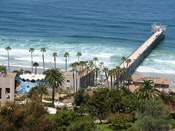
San Diego’s Beaches Closed Amidst Mysterious Seaweed InvasionSan Diego’s Beaches Closed Amidst Mysterious Seaweed Invasion San Diego’s iconic beaches have been closed indefinitely as officials grapple with an unprecedented invasion of mysterious seaweed. The unidentified algae, dubbed “green slime” by locals, has blanketed the coastline, rendering swimming and other recreational activities unsafe. The invasion was first reported last week by lifeguards who noticed an unusual influx of seaweed washing ashore. Within days, miles of beach had been covered in thick layers of the viscous substance. Authorities have launched an investigation into the cause of the invasion but have yet to determine its origin or species. Tests are underway to assess the potential toxicity of the seaweed and its impact on marine life. “We’ve never seen anything like this before,” said Dr. Emily Smith, a marine biologist at the Scripps Institution of Oceanography. “The sheer volume and the unknown nature of this seaweed are concerning.” The closure of the beaches has devastated local businesses and residents alike. Summer is peak tourist season in San Diego, and the closure is expected to cause significant economic losses. Surfers and beachgoers are particularly disappointed. “This is my favorite time of year to be in the ocean,” said surfer Mark Johnson. “It’s heartbreaking to see the beaches closed like this.” Officials have urged the public to avoid contact with the seaweed and to stay out of the water until further notice. They also warned that the seaweed could be a breeding ground for bacteria and other harmful organisms. Clean-up crews are working around the clock to remove the seaweed, but the task is daunting. The algae is heavy and slippery, making it difficult to collect. “This is a major environmental and public health challenge,” said San Diego Mayor Todd Gloria. “We are working tirelessly to address it and get our beaches back open as soon as possible.” The seaweed invasion has raised concerns about global climate change and its potential impact on marine ecosystems. Scientists believe that warmer ocean temperatures could create favorable conditions for algae blooms to occur more frequently and with greater intensity. For now, San Diego’s beaches remain closed, casting a pall over what should be a time of summer fun and relaxation. Residents and visitors alike anxiously await the day when they can safely return to their beloved coastline.
San Diego’s beaches closed due to mysterious seaweed invasion
Related Posts
Kate Hudson Recreated Her Iconic How to Lose a Guy in 10 Days Scene During the World Series, and I Can’t Ignore the Fans’ Reaction to It
Kate Hudson isn’t just an award-winning one actress with famous parents; she is also a huge baseball fan. So it’s no surprise that she attended this year’s World Series to…
Software Catalog Unveils Array of Cutting-Edge Solutions for Enterprise Transformation
Software Catalog Unveils Array of Cutting-Edge Solutions for Enterprise TransformationSoftware Catalog Unveils Array of Cutting-Edge Solutions for Enterprise Transformation Technology is rapidly reshaping the business landscape, making it imperative for…